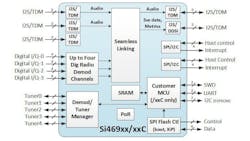Digital-Radio Coprocessors Power Automotive Infotainment Systems
This article is part of the TechXchange: Software-Defined Radio.
The Overview
A new family of automotive digital-radio coprocessors from Skyworks Solutions, the Si469xx family, brings high integration, flexibility, and low cost to future in-vehicle infotainment (IVI) systems. The Si469xx family of coprocessors is optimized to operate with Skyworks’ Si479xx hybrid software-defined-radio (SDR) tuners to achieve a cost-effective digital radio receiver.
Who Needs It & Why?
HD Radio is firmly entrenched in automakers’ infotainment playbooks in the U.S., while DAB/DAB+ is the mode of choice in the European Union. Historically, automotive radios have been ensconced in the “head unit” or cockpit system in the middle of dashboards.
Now, though, car radios are increasingly being implemented in a separate module known as a remote tuner module (RTM). Implementation in this fashion brings the benefits of less cable weight and, perhaps more importantly for automakers, the ability to design and qualify the RTM for use in multiple car models. Thus, it’s decoupled from development of the cockpit system.
Under the Hood
The Si469xx devices can demodulate and decode up to four digital-radio channels supporting HD Radio, DAB/DAB+, DRM (for AM and FM), and CDR, providing high performance and unmatched scalability. They also support advanced capabilities such as maximal ratio combining (MRC) and seamless linking of digital radio, analog radio, and Internet Protocol content (see figure).
Thanks to an integrated customer-programmable microcontroller (MCU), the Si469xx can significantly reduce bill-of-materials (BOM) costs by eliminating the need for an external MCU and its support components. Software design is simplified through several improvements, including a Demod/Tuner Manager that relieves system developers from having to program low-level radio control functions.
The cable weight reductions are a result of replacing RF coaxial cabling to the head unit with a much lighter twisted-pair cabling, typically accomplished with Analog Devices’ A2B technology. A2B technology is optimized for automotive digital-audio applications, or ethernet.
By leveraging separate tuner and coprocessor ICs, the Si469xx family offers an optimal balance between partitioning and integration, which helps solve thermal challenges associated with RTM applications. This also delivers robust scalability and configurability to address multiple regions and performance points. System designers can create a single-board design and populate it with different pin/package and software API-compatible devices.
More information about the Si469xx family of digital radio coprocessors can be found here. The production release is expected in the first half of 2024.
Read more articles in the TechXchange: Software-Defined Radio.
About the Author
David Maliniak
Executive Editor, Microwaves & RF
I am Executive Editor of Microwaves & RF, an all-digital publication that broadly covers all aspects of wireless communications. More particularly, we're keeping a close eye on technologies in the consumer-oriented 5G, 6G, IoT, M2M, and V2X markets, in which much of the wireless market's growth will occur in this decade and beyond. I work with a great team of editors to provide engineers, developers, and technical managers with interesting and useful articles and videos on a regular basis. Check out our free newsletters to see the latest content.
You can send press releases for new products for possible coverage on the website. I am also interested in receiving contributed articles for publishing on our website. Use our contributor's packet, in which you'll find an article template and lots more useful information on how to properly prepare content for us, and send to me along with a signed release form.
About me:
In his long career in the B2B electronics-industry media, David Maliniak has held editorial roles as both generalist and specialist. As Components Editor and, later, as Editor in Chief of EE Product News, David gained breadth of experience in covering the industry at large. In serving as EDA/Test and Measurement Technology Editor at Electronic Design, he developed deep insight into those complex areas of technology. Most recently, David worked in technical marketing communications at Teledyne LeCroy, leaving to rejoin the EOEM B2B publishing world in January 2020. David earned a B.A. in journalism at New York University.


